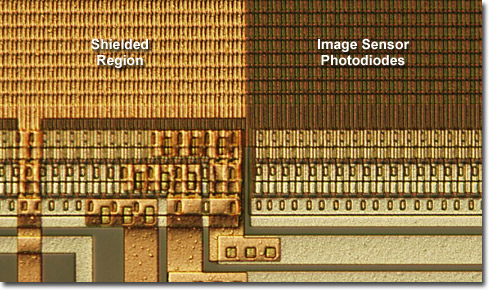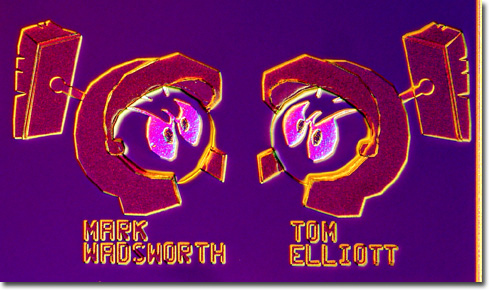A Dog's Life (Differential Interference Contrast)
View this silicon artwork under brightfield and darkfield illumination.
|
We managed to capture a photograph of what are now perhaps the tiniest Martians on Mars. Appearing as an opposed duet of helmeted gladiators, these angry silicon soldiers were discovered on the surface of an image sensor used by the Spirit and Opportunity rovers sent to probe the Red planet. Maybe these are the ONLY Martians on Mars? Probably not. In any event, the chip was loaned to us by designer Mark Wadsworth who is a fan of the Silicon Zoo. Mark informs us that he decided to try his hand at silicon artwork after visiting the Zoo on several occasions. The title of his artwork is the "Dueling Marvin the Martians". Mark designed the image sensor for NASA's Jet Propulsion Laboratory along with Tom Elliot, who actually did the testing of the flight candidate imagers to select the 20 or so that actually made it on the two missions. Tom and Mark tended to butt heads quite a bit, which was the inspiration for the doodle. The rover image sensors are charge-coupled devices (CCDs) much like those found in ordinary everyday digital cameras, but with several advanced features. In order to speed image capture, the CCD uses frame transfer technology to quickly shift the captured image behind a mask (the shielded region electronic shutter in the image below) after the photodiodes have accumulated sufficient charge (relating to the image intensity). This particular sensor contains 1024 x 1024 pixels, each of which is 12-micrometers square. The chip is a custom design that was developed to meet the rather stringent performance criteria cooked up by the mission's brainchild (Dr. S. Squyers) and his group at Cornell University. 
Martian Rover Image Sensor Surface Structure Throughout history Mars has been shrouded in mystery, but today the object of wonder that has inspired countless fantasies and science fiction stories is being exposed to inquiring minds like never before. In the summer of 2003, NASA separately launched two Mars Exploration Rovers, both destined to travel across vast expanses of space in order to touchdown on the surface of the red planet approximately seven and a half months after liftoff. The first of the twin vehicles to land on Mars was the rover dubbed "Spirit," a 400 million dollar NASA craft that perilously settled in the area of the Martian Gusev Crater late at night on January 3, 2004. The following day, as the vehicle absorbed the rays of the sun in order to power its solar panels enough for it to awaken for the first time on a different planet, enthusiastic mission controllers sent a transmission to Spirit of the lively Beatles' song "Good Morning, Good Morning" in a playful attempt to help enliven the rover. Though the Spirit rover did not roll off of its airbag-protected landing craft as quickly and easily as mission controllers might have hoped, the vehicle is much more mobile and capable than any of the exploratory craft that have most recently been to Mars, including the toy-sized test rover Sojourner that was included as part of the 1997 Pathfinder mission. Spirit is equipped with a complex arm and wheels with individual steering motors, as well as a strong outer body called the warm electronics box that protects the rover's sensitive electronics, including state-of-the-art temperature controls and computers. Often likened to a robot geologist, Spirit is also outfitted with a wide array of scientific instrumentation to help the rover achieve its primary goals, which include searching for and characterizing a range of rocks and soils that may contain crucial evidence regarding past conditions on Mars, especially the planet's possible water activity. In order to "see" and image the Martian environment, Spirit, as well as its twin "Opportunity," is equipped with nine separate cameras, six of which aid in navigation of the rover and three that are designed to perform scientific investigations. The CCD image sensor chips that are critical components of these cameras were produced by DALSA Corporation, a global leader in digital imaging components and specialized semiconductor manufacturing, and were designed in collaboration with NASA's Jet Propulsion Laboratory. The most sophisticated of Spirit's cameras is the Pancam that has successfully generated unprecedented stunning high-resolution color images of the red planet's surface and atmosphere. Comprised of a stereo pair of CCD cameras secured to a bar on top of the mast of the rover, the Pancam is capable of rotating a complete 360 degrees and the bar that it is attached to can move up or down 180 degrees. This innovative design enables the assembly to generate impressive panoramic 96 megapixel images. |
© 1995-2025 by Michael W. Davidson and The Florida State University. All Rights Reserved. No images, graphics, software, scripts, or applets may be reproduced or used in any manner without permission from the copyright holders. Use of this website means you agree to all of the Legal Terms and Conditions set forth by the owners.
This website is maintained by our
|
